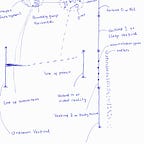The Gun Violence, off Mental Health | Neuroscience | Mass Shootings |
Whatever role mental health plays in gun-related fatalities is part of mental care’s refusal to evolve with the era.
Many of the methods predate the internet, sandwiching approaches with opacity.
What does it mean to see a gun as a tool for violence?
Seeing is sensory. Knowing is memory. What relays is thought.
Where does thought go? How does it drive behavior? What role does the memory play?
Whatever the answers are, how removed are they from hard science to general knowledge?
How does knowledge about thought transport ensure that those closest to people can better measure their mind temperature, detecting diminutive cues, before tragic acts?
Mental health is understood to be many things, but tough because no one knows what to look for.
What relays in mental health? To what stations?
These could become architectural maps — to know where thought is, and avoid it [control] from going down [automatic].
Neuroimaging does not show thought, so it has little relevance in organizing what is necessary to be known.
In the brain, there is multisensory integration — or convergence of sensory input, or where senses are collected.
It is the olfactory bulb for smell and the thalamus for all other senses. It is from there they get relayed, to the cortex — to begin interpretation.
Interpretation includes knowing, feeling then reaction.
What gets relayed are thoughts, and stations include the memory, then centers for fear, pain, pleasure and so on, with reactions — subsequently.
How can this be displayed digitally, to show how thought emerges and transports across behavioral rungs, exposing what transverses within the head, notifying for attention before something horrific happens?
This path is a new direction in the convoluted problem of whatever responsibility mental health has for gun violence.
